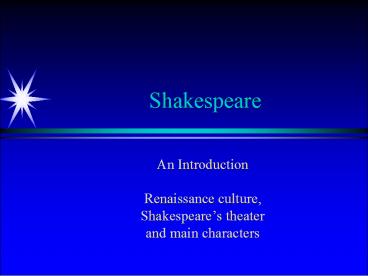Shakespeare - PowerPoint PPT Presentation
1 / 17
Title:
Shakespeare
Description:
If a character dies, Shakespeare must find a way to get the body off the stage. Shakespeare must invent reason for characters to exit the stage ... – PowerPoint PPT presentation
Number of Views:534
Avg rating:3.0/5.0
Title: Shakespeare
1
Shakespeare
- An Introduction
- Renaissance culture,
- Shakespeares theater
- and main characters
2
Dominant Renaissance World Views
- Great Chain of Being
- Belief structure from middle ages
- Came from Ptolemaic system with earth at the
center - Hierarchical system with God and angels above,
man in the middle, and animals, plants, minerals
on the bottom. - Within each species, same hierarchy, with King on
the top, then nobles, moneyed middle-class, then
peasants
3
Dominant Renaissance World Views
- Great Chain of Being
- System of Order, corresponding with belief in
predestination, God has plan for world - Order can be thrown into chaos if hierarchy not
adhered to, if subjects rebel against monarch,
sons against fathers - Suggests everyone has purpose or role in life,
should use reason and/or to find and fulfill
purpose
4
Dominant Renaissance World Views
- Humanist views
- To the Christian belief system, the Renaissance
added the Humanist beliefs of self-determinism. - There was still an Ideal beyond the world as we
know it, but we were to strive to reach that
Ideal (or at least be worthy of it) - Thus two supposed opposites, predestination and
free will, were combined in the Renaissance
Christian Humanist belief system - The Renaissance Christian Humanists purpose was
to make of himself his ideal Self
5
Dominant Renaissance World Views
- Christian Humanist
- History as moral lesson
- Overarching plan
- Great Chain of Being
- Nature understood through Bible
- language metaphor
- Machiavellian
- History as natural cycle
- Chance or fortune
- Man makes own place
- Nature understood by logic, reason
- language scientific
6
Dominant Renaissance World Views
- Language
- Renaissance Christian Humanist -- poetry
- Metaphoric or figurative language used to
illustrate place in hierarchies - Since Sun and King are on top of their respective
groups, they are joined together through metaphor
Metaphoric or figurative language used to
illustrate place in hierarchies - Machiavellian prose
- Scientific, logical language used to show
importance of reason
7
Dominant Renaissance World Views
- Christian Humanist
- State microcosm of Divine world
- Divine Right of Kings
- Time and change moving toward perfection
vertical concept of time - Identity is temporal role moving toward spiritual
essence (Ideal Self).
- Machiavellian
- State/politics based on power not right
(privilege or correctness) - Time and change cyclical, not advancing
- Identity plural, who we are in which situation or
time, we can play many roles
8
The Great Chain of Being
- derived from Ptolemaic view of earth at center
- orderly universe, everything has place and
purpose - the hierarchies used in metaphoric language
- king associated with sun, lion, head, air
- antagonist associated with moon, snake, feet,
earth - reality tied with moral truth, what ought to be
- mans place in the world determined by birth
- belief in the guiding hand of Providence
9
Characters often found in Shakespeare plays
- the Fair
- past as heroic myth
- ideal world
- world of heroic action
- advice giving and tradition
- the Foul
- present as corrupt society
- unweeded garden
- world of Machiavellian intrigue
- spying and conflict
10
Characters often found in Shakespeare plays
- the Fair
- innocence and idealism
- belief and trust
- ideal character
- remembered past
- the Foul
- experience and cynicism
- suspicion and doubt
- malcontent, deceiver
- experienced present
11
Staging
- No set design -- actors must establish setting,
time - Few props -- actors must bring on throne, table,
chair, then take them off stage again - Stage has trap door, two entrances, balcony area
12
Staging
- If a character dies, Shakespeare must find a way
to get the body off the stage - Shakespeare must invent reason for characters to
exit the stage - The stage is a fixed place, so certain areas can
be associated with a character
13
Reading the plays
- No Act, scene divisions originally, editors
added - Use of 5 acts is an editors choice
- could see all plays in three acts
- Act 1 -- introduces issues, ends in instigating
event - Act 2-4 -- develops issues and characters
- includes midpoint pivotal event
- includes second turning point
- Act 5 -- climax, resolves conflicts
- No stage directions (enter Hamlet), dialogue
used
14
Reading the plays
- Conventionally important scenes
- Act 1, scene 2 ( or -) Court scene
- Introduce main characters, issues, themes
- Act 3, scene 2 ( or -) Court scene
- Climax, direction of plot turns toward inevitable
end - Act 5, scene 2 ( or -) Court scene
- Ending, all issues / themes resolved
15
Characters
- Primary
- dynamic, change
- complex, are revealed
- Protagonist
- Antagonist
- Secondary
- static, dont change
- simpler, stereotyped
- Reflective, reveal something about main characters
16
Plot structures
- Rise and Fall
- external / condition
- gaining/losing power
- internal / character
- become more aware
- become more complex
- less formal, fixed to role
- more analytical of self
- language less formal
17
Plot structures
- Main plot/subplot
- Main plot
- protagonist/antagonist
- court world/macrocosm
- major actions
- Subplot
- reflective characters, comment on main actions
- foiling with main characters
- private world/microcosm
Main plot
Subplot
Main
Sub
Main































